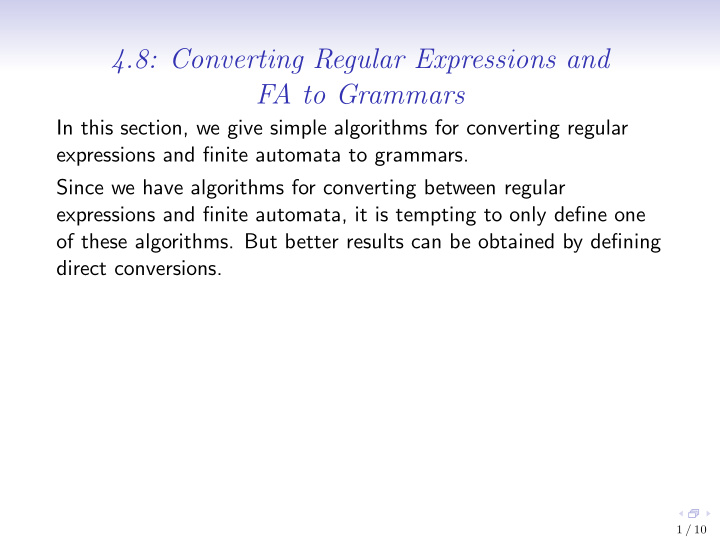



4.8: Converting Regular Expressions and FA to Grammars In this section, we give simple algorithms for converting regular expressions and finite automata to grammars. Since we have algorithms for converting between regular expressions and finite automata, it is tempting to only define one of these algorithms. But better results can be obtained by defining direct conversions. 1 / 10
Converting Regular Expressions to Grammars Regular expressions are converted to grammars using a recursive algorithm that makes use of some of the operations on grammars that were defined in Section 4.7. The structure of the algorithm is very similar to the structure of our algorithm for converting regular expressions to finite automata. This gives us a function regToGram ∈ Reg → Gram . The algorithm is implemented in Forlan by the function val fromReg : reg -> gram of the Gram module. It’s available in the top-level environment with the name regToGram . 2 / 10
Converting Regular Expressions to Grammars Here is how we can convert the regular expression 01 + 10(11) ∗ to a grammar using Forlan: - val gram = regToGram(Reg.input ""); @ 01 + 10(11)* @ . val gram = - : gram - Gram.output = ("", Gram.renameVariablesCanonically gram); {variables} A, B, C, D, E, F {start variable} A {productions} A -> B | C; B -> 01; C -> DE; D -> 10; E -> % | FE; F -> 11 val it = () : unit 3 / 10
Converting Finite Automata to Grammars Suppose M is an FA. We define a function/algorithm faToGram ∈ FA → Gram by, for all FAs M , faToGram M is the grammar G defined below. If Q M ∩ alphabet M = ∅ , then G is defined by • Q G = Q M ; • s G = s M ; • P G = { q → xr | q , x → r ∈ T M } ∪ { q → % | q ∈ A M } . Otherwise, we first rename the states of M using a uniform number of � and � pairs, so as to avoid conflicts with the elements of M ’s alphabet. 4 / 10
Converting Finite Automata to Grammars For example, suppose M is the DFA 1 1 0 Start A B 0 Our algorithm converts M into the grammar A → % | 0B | 1A , B → 0A | 1B . 5 / 10
Converting FAs to Grammars Consider, e.g., the valid labeled path for M 1 0 0 ⇒ A ⇒ B ⇒ A , A which explains why 100 ∈ L ( M ). It corresponds to the valid parse tree for G A 1 A 0 B 0 A % , which explains why 100 ∈ L ( G ). 6 / 10
Converting FA’s to Grammars If we have converted an FA M to a grammar G , we can prove L ( M ) ⊆ L ( G ) by induction on the lengths of labeled paths, and we can prove L ( G ) ⊆ L ( M ) by induction on parse trees. Thus we have L ( G ) = L ( M ). 7 / 10
Converting FA’s to Grammars The Forlan module Gram contains the function val fromFA : fa -> gram which implements our algorithm for converting finite automata to grammars. It’s available in the top-level environment with the name faToGram . 8 / 10
Converting FA’s to Grammars Suppose fa of type fa is bound to M . Here is how we can convert M to a grammar using Forlan: - val gram = faToGram fa; val gram = - : gram - Gram.output("", gram); {variables} A, B {start variable} A {productions} A -> % | 0B | 1A; B -> 0A | 1B val it = () : unit 9 / 10
Consequences of Conversion Functions Because of the existence of our conversion functions, we have that every regular language is a context-free language. On the other hand, the language { 0 n 1 n | n ∈ N } is context-free, because of the grammar A → % | 0A1 , but is not regular, as we proved in Section 3.14. Summarizing, we have: Theorem 4.8.2 The regular languages are a proper subset of the context-free languages: RegLan � CFLan . 10 / 10
Recommend
More recommend